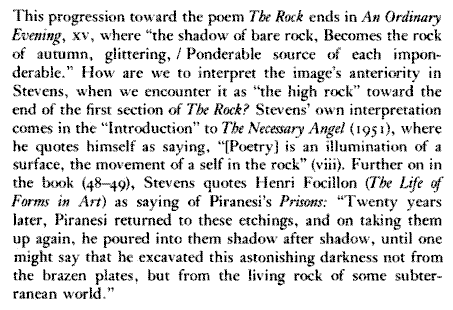Susanne for Suzanne
From pages 7-8 of William York Tindall's Literary Symbolism (Columbia U. Press, 1955)—
... According to Cassirer's Essay
on Man, as we have seen, art is a symbolic form, parallel in respect
of this to religion or science. Each of these forms builds up a universe
that enables man to interpret and organize his experience; and each
is a discovery, because a creation, of reality. Although similar in func-
tion, the forms differ in the kind of reality built. Whereas science
builds it of facts, art builds it of feelings, intuitions of quality, and
the other distractions of our inner life— and in their degrees so do
myth and religion. What art, myth, and religion are, Cassirer con-
fesses, cannot be expressed by a logical definition.
Nevertheless, let us see what Clive Bell says about art. He calls
it "significant form," but what that is he is unable to say. Having
no quarrel with art as form, we may, however, question its signifi-
cance. By significant he cannot mean important in the sense of
having import, nor can he mean having the function of a sign;
for to him art, lacking reference to nature, is insignificant. Since,
however, he tells us that a work of art "expresses" the emotion of
its creator and "provokes" an emotion in its contemplator,he seems
to imply that his significant means expressive and provocative. The
emotion expressed and provoked is an "aesthetic emotion," contem-
plative, detached from all concerns of utility and from all reference.
Attempting to explain Bell's significant form, Roger Fry, equally
devoted to Whistler and art for art's sake, says that Flaubert's "ex-
pression of the idea" is as near as he can get to it, but neither Flaubert
nor Fry tells what is meant by idea. To "evoke" it, however, the artist
creates an "expressive design" or "symbolic form," by which the
spirit "communicates its most secret and indefinable impulses."
Susanne Langer,who occupies a place somewhere between Fry
and Cassirer, though nearer the latter, once said in a seminar that a
work of art is an "unassigned syntactical symbol." Since this defini-
End of page 7
tion does not appear in her latest book, she may have rejected it, but
it seems far more precise than Fry's attempt. By unassigned she prob-
ably intends insignificant in the sense of lacking sign value or fixed
reference; syntactical implies a form composed of parts in relation-
ship to one another; and a symbol, according to Feeling and Form,
is "any device whereby we are enabled to make an abstraction." Too
austere for my taste, this account of symbol seems to need elaboration,
which, to be sure, her book provides. For the present, however, taking
symbol to mean an outward device for presenting an inward state,
and taking unassigned and syntactical as I think she uses them, let
us tentatively admire her definition of the work of art.


Oh, the red leaf looks to the hard gray stone
To each other, they know what they mean
— Suzanne Vega, "Song in Red and Gray"
























